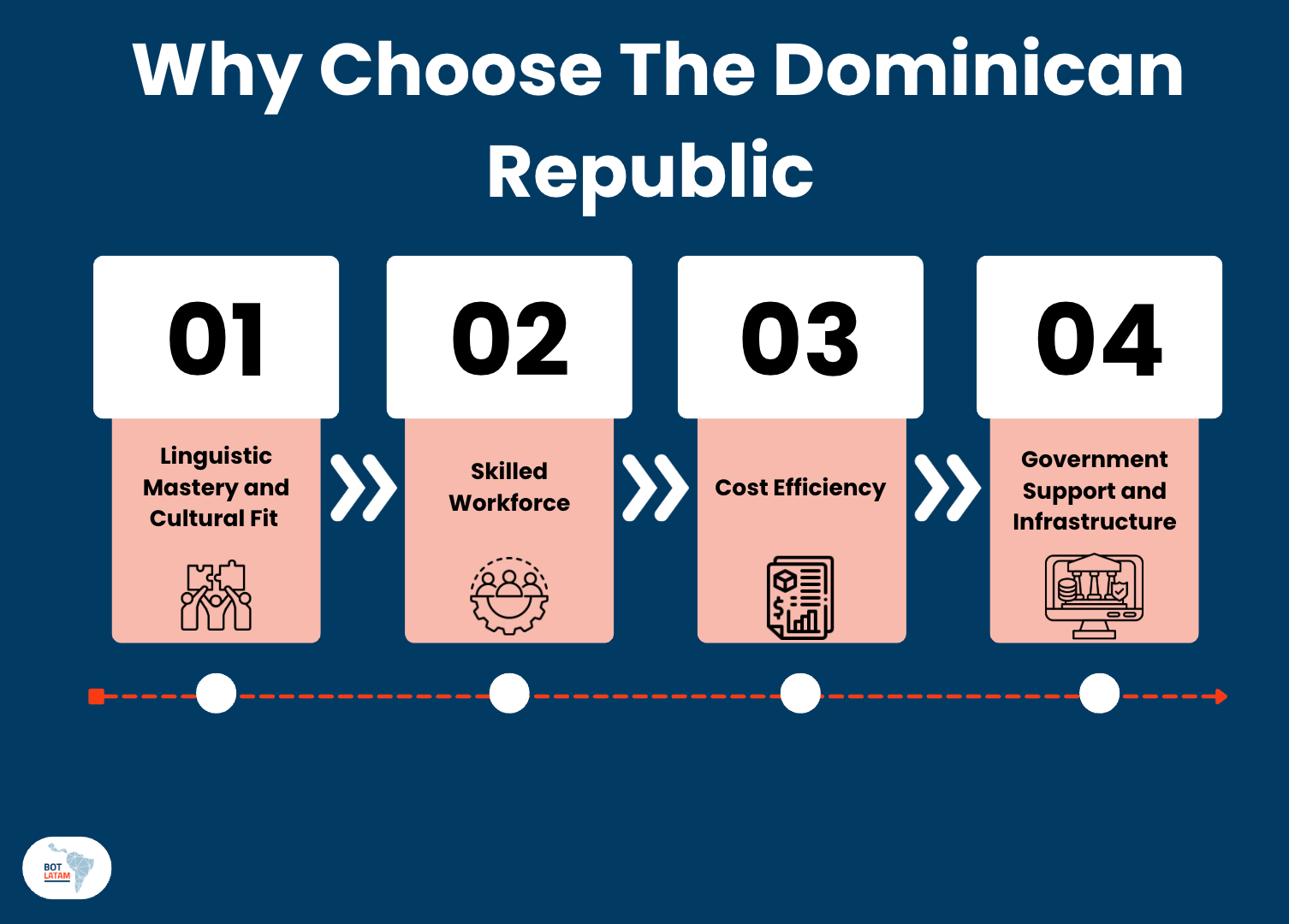Setting up a Nearshore Center of Excellence (CoE) in the Dominican Republic is no longer just a cost-saving move, it’s a growth strategy. As U.S. and European companies seek to expand their tech capabilities, the Dominican Republic has quietly emerged as one of Latin America’s most promising nearshore destinations.
You’ll find more than just proximity here. The country offers a deep talent pool, stable infrastructure, and strong cultural alignment with North American markets. In fact, according to the Inter-American Development Bank, the Dominican Republic’s technology services sector has grown by over 22% in the past five years, making it one of the region’s fastest-emerging IT hubs.
This article breaks down everything you need to know to establish a Nearshore CoE in the Dominican Republic, from understanding the CoE model to choosing the right city, leveraging the BOT (Build-Operate-Transfer) framework, and scaling operations sustainably. Whether your goal is innovation, agility, or long-term expansion in LATAM, this guide walks you through each step of the process.
What Is a Nearshore Center of Excellence (CoE)?
A Nearshore Center of Excellence (CoE) is a dedicated hub that centralizes expertise, innovation, and process optimization for a company’s core operations. Unlike a typical outsourcing setup, a CoE focuses on developing best practices, driving efficiency, and fostering continuous improvement within specific domains, such as software engineering, data analytics, AI development, or customer experience.
When nearshored, the CoE operates from a neighboring country with similar time zones and cultural compatibility, allowing your internal teams to collaborate in real time. This model balances the strategic control of in-house teams with the scalability and cost efficiency of nearshore operations. For example, a U.S. company can establish a CoE in the Dominican Republic and manage it as an integrated extension of its headquarters rather than as a separate vendor operation.
The goal is to consolidate specialized knowledge and capabilities where they can be most effective. According to Deloitte’s Global Shared Services and Outsourcing Survey, 73% of organizations with Centers of Excellence report improved innovation and cross-functional collaboration. These hubs often act as incubators for digital transformation, helping enterprises pilot emerging technologies and refine processes before scaling them globally.
In practice, a Nearshore CoE becomes more than a delivery center, it’s a strategic command post for driving business excellence. It supports agility, accelerates project timelines, and ensures consistent quality across teams and regions. By establishing your CoE in a nearshore market like the Dominican Republic, you gain access to skilled professionals, lower operational barriers, and stronger alignment with your company’s long-term growth goals.
Why The Dominican Republic Is Emerging as a Nearshore Center of Excellence

Strategic Location and Time Zone Alignment.
The Dominican Republic’s location gives it a unique edge for nearshore operations. Sitting in the Atlantic Standard Time Zone, it shares overlapping business hours with major U.S. cities such as New York, Miami, and Chicago. This allows development teams, project managers, and executives to collaborate in real time without the communication delays common in offshore models. For teams running agile sprints or 24-hour support cycles, that time alignment can make a measurable difference in project velocity and responsiveness.
Expanding Tech Talent Pool.
The country’s workforce is becoming one of the strongest in the Caribbean for technology-driven services. The Inter-American Development Bank reports that the Dominican Republic’s technology and business services sector grew by over 22% between 2018 and 2023. Universities and technical institutes have also boosted STEM enrollment, with thousands of new graduates each year in software engineering, data analytics, and IT management. Combined with English proficiency and cultural alignment with North American work practices, this talent base is fueling the rise of Nearshore CoEs in the region.
Strong Infrastructure and Connectivity.
Reliable digital and physical infrastructure supports the Dominican Republic’s growing reputation as a nearshore hub. The country ranks among the top in the Caribbean for broadband penetration and international connectivity, according to ITU Data. Several technology parks and free zones, such as Santo Domingo Cyber Park, have been developed to attract global firms seeking stable, high-speed networks and secure data environments. Modern office spaces, data centers, and fiber connectivity allow companies to set up CoEs with minimal downtime or infrastructure gaps.
Government Support and Business Incentives.
The Dominican government actively promotes technology investment through pro-business policies and incentives. The Law No. 8-90 on Free Zones offers tax exemptions on imports, exports, and corporate income for companies operating within designated zones, a key advantage for firms establishing Centers of Excellence. Public-private partnerships, like the National Digital Strategy, also aim to position the country as a regional leader in innovation, education, and digital services. This ongoing commitment creates a predictable, business-friendly environment for nearshore expansion.
Cost Efficiency and Operational Stability.
Compared to other Latin American markets, the Dominican Republic offers competitive labor and operational costs while maintaining high service standards. According to KPMG’s Competitive Alternatives Report, operating costs in Santo Domingo are up to 35% lower than in major U.S. cities. The country’s stable economy and growing middle class also contribute to long-term sustainability, reducing risk for companies looking to build and scale nearshore CoEs with reliable local partnerships.
Cultural Affinity and Language Advantage.
Cultural proximity to the U.S. and widespread bilingualism make integration smoother for global teams. English is taught from primary school onward, and many professionals have experience working with U.S.-based clients. That familiarity with Western business norms, punctuality, accountability, and collaboration minimizes cultural friction and strengthens alignment across distributed teams. It’s a soft advantage that directly impacts productivity and client satisfaction within a CoE model.
Growing Ecosystem for Innovation and Nearshore Collaboration.
Beyond talent and infrastructure, the Dominican Republic is nurturing a broader innovation ecosystem. Tech incubators, coding bootcamps, and multinational partnerships are driving digital transformation across industries. Cities like Santo Domingo and Santiago are emerging as nearshore innovation clusters, attracting startups and enterprises alike. This ecosystem effect makes it easier for companies to recruit, partner, and experiment, essential for CoEs focused on R&D, process excellence, and continuous improvement.
Steps to Set Up a Nearshore CoE in The Dominican Republic
1. Define the Strategic Vision and Objectives:
Start by clarifying the purpose of your Nearshore Center of Excellence (CoE). Identify which business functions will benefit most from centralization, whether it’s software development, analytics, IT operations, or customer support. Establish measurable goals such as improving delivery speed, reducing costs, or driving innovation across teams. A clear strategic vision ensures that every operational decision aligns with your company’s global objectives. According to Gartner, organizations with defined CoE strategies are 40% more likely to achieve measurable performance gains within their first year of operation.
2. Select the Right City and Location:
Choosing the right location within the Dominican Republic is critical. Santo Domingo offers strong connectivity, bilingual talent, and modern infrastructure, while Santiago de los Caballeros provides competitive costs and access to growing university networks. Assess factors such as labor availability, transportation, data security, and access to free trade zones. The Dominican Association of Free Zones notes that companies operating within these areas can benefit from up to 100% tax exemptions on key operational expenses, a major incentive for setting up a CoE.
3. Establish the Legal and Operational Framework:
Before hiring or building infrastructure, ensure your CoE complies with local business regulations. Work with legal advisors familiar with Law No. 8-90 on Free Zones and the National Council of Export Free Zones (CNZFE) requirements. Establish your entity type, obtain the necessary permits, and define intellectual property protections. Setting up compliant HR policies, tax structures, and local banking arrangements early helps prevent operational delays and builds credibility with both local authorities and partners.
4. Build and Train a High-Performance Team:
Once your foundation is in place, focus on talent acquisition and capability development. Partner with Dominican universities and training programs to source skilled professionals in technology, engineering, and business operations. According to UNESCO data, over 35% of Dominican university graduates now come from STEM-related fields, supporting long-term scalability for nearshore operations. Implement continuous training and mentorship to align local teams with your corporate standards, methodologies, and tools.
5. Implement Scalable Governance and Knowledge Transfer:
Strong governance defines how your CoE operates day to day. Create frameworks for decision-making, accountability, and performance measurement that reflect both global and local business realities. Adopt metrics such as delivery timelines, quality scores, and innovation output to track success transparently. Establish structured knowledge transfer programs so expertise flows between headquarters and your Dominican Republic team, minimizing silos and ensuring process consistency as the CoE matures.
6. Leverage Technology Infrastructure and Security Standards:
Modern CoEs rely on technology as their backbone. Invest in high-speed connectivity, secure data centers, and cloud-based collaboration tools to support remote and hybrid work models. The International Telecommunication Union ranks the Dominican Republic among the Caribbean’s top three countries for ICT access and broadband reliability, making it well-suited for digitally driven CoEs. Prioritize cybersecurity compliance and data privacy to meet international standards like ISO 27001 and GDPR, especially if you manage cross-border operations.
7. Plan for Growth and Continuous Improvement:
Your Nearshore CoE should evolve alongside your business. Design the operating model for scalability, both in headcount and in the range of services offered. Introduce feedback loops, process audits, and innovation initiatives to drive long-term excellence. Establishing partnerships with local tech associations and innovation hubs helps you stay ahead of labor market trends and emerging technologies, ensuring your Dominican Republic CoE remains competitive and future-ready.
Leveraging the BOT Model for a Dominican CoE
Understanding the Build-Operate-Transfer (BOT) Model:
The Build-Operate-Transfer (BOT) model is a structured approach that helps companies establish a Nearshore Center of Excellence (CoE) efficiently while minimizing risk. In this model, a local partner sets up and manages the CoE during the early phases, handling recruitment, infrastructure, and operations — before transferring full ownership to your company once the center reaches maturity. It’s a proven framework for scaling global operations without the heavy upfront investment or steep learning curve of entering a new market.
This model has become particularly relevant in Latin America’s nearshore ecosystem, where companies seek speed, cost efficiency, and talent access.
How BOT Reduces Risk When Launching a Nearshore CoE:
Establishing a CoE from scratch in another country often brings logistical and regulatory challenges. The BOT model mitigates these risks by leveraging local expertise during the build and operate phases. Your nearshore partner handles compliance with Dominican business regulations, labor laws, and tax frameworks under Law No. 8-90 on Free Zones. This ensures a legally sound foundation while you focus on defining the CoE’s strategic direction and performance metrics.
Operational risk is further reduced through shared accountability. During the “Operate” phase, the partner manages day-to-day delivery and governance, giving you access to real-time data on productivity, quality, and financial performance. When it’s time to transfer ownership, the CoE already functions smoothly, with processes, teams, and culture aligned to your organization’s standards.
Advantages of BOT for a Dominican CoE:
Using a BOT structure in the Dominican Republic offers unique advantages. It enables rapid entry into a talent-rich market without the burden of immediate incorporation or infrastructure investment. The Dominican Association of Free Zones reports that nearshore service companies can cut operational costs by up to 35% through the country’s fiscal incentives and workforce efficiencies, benefits that are often fully realized during the BOT’s “Operate” phase.
Additionally, the model facilitates knowledge transfer and continuity. Once the CoE transitions to your ownership, you inherit trained teams, optimized workflows, and localized expertise. This reduces ramp-up time and allows for faster innovation cycles compared to traditional outsourcing or offshoring. The flexibility of the BOT approach also makes it easier to scale the CoE across multiple service lines or LATAM locations once it’s stabilized.
Transitioning From BOT to Full Ownership:
The transfer stage is where a BOT-built CoE becomes a long-term strategic asset. This phase involves legal handover, rebranding, and integration with your corporate governance structure. Transparent transition planning, including documentation of all processes, IP rights, and employee agreements, ensures a seamless changeover. Most companies complete this transition within 18 to 36 months, depending on CoE complexity and service scope.
Post-transfer, maintaining continuity is critical. Establish joint leadership committees during the final months of the BOT phase to align on KPIs, compliance, and cultural integration. Once ownership is complete, you retain full operational control while benefiting from an established, high-performing CoE in the Dominican Republic that continues to operate under the same proven systems and standards.
Ready to Set Up a Nearshore CoE in The Dominican Republic?
Building a Nearshore Center of Excellence (CoE) in the Dominican Republic has become a strategic move for companies looking to strengthen their operations in Latin America. With a rapidly growing tech workforce, favorable business incentives, and reliable infrastructure, the country offers a near-perfect balance between cost efficiency and operational excellence.
At BOT LATAM, we specialize in helping organizations establish and scale Centers of Excellence across Latin America using the Build-Operate-Transfer model. Our team manages every stage, from local compliance and recruitment to operations and handover, ensuring that companies build stable, high-performing teams without unnecessary risk or delays.
We’ve seen firsthand how the right CoE structure can accelerate innovation, streamline delivery, and strengthen global competitiveness. Suppose your company is ready to explore the potential of the Dominican Republic as a nearshore CoE destination. In that case, we can provide the local insight and operational expertise to make it happen efficiently, transparently, and with long-term results. Contact us to make it happen!

Revolutionize Your Workflow with Our Innovative BOT Strategy!
Enhance your operations seamlessly and adapt to market demands
Contact Us

.jpg)


%2017.26.38.png)